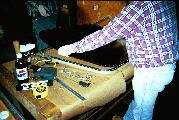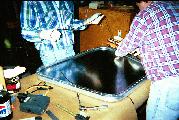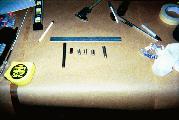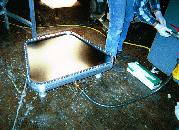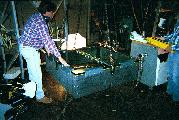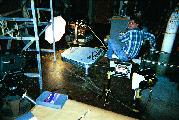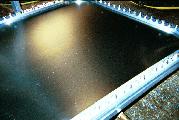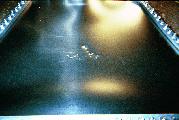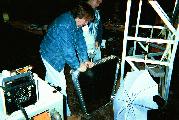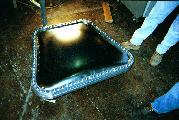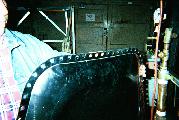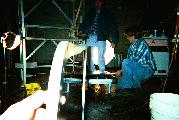Photos of Testing the Titanium Vacuum Windows for the G0 ExperimentOn 12/13/99 we tested the first vacuum window for the G0 spectrometer. The vacuum windows are used to seal the vacuum of the spectrometer, but they must be thin enough to be transparent to the radiation exiting the spectrometer that needs to get to the detectors outside the vacuum vessel. This window is made from Timet's Ti 15-3 alloy, one of the strongest titanium alloys available. The first windows we tested were .020" thick because that is the thinnest stock thickness available. They were laser machined at Laser Technolgies, Inc in Batavia, IL. We calculated that if the window fractured it was possible for fragments to have the kinetic energy of bullets and they could be razor sharp. For this reason, Bartoszek Engineering designed a bullet proof box to perform the tests inside. The tall pipe in some of the pictures is the drop pipe to allow projectiles of known mass to be dropped from known heights on the window. In this way, the energy of impact on the window can be calculated. The first test was a vacuum test. We dropped projectiles on the window from different heights. When it was determined that the window was very robust, we removed the bullet proof cover and leak checked the assembly. It was completely tight. We were unable to do more than create pin hole leaks by dropping sharpened center punches from 12 feet above the window. The window did not fail completely around puncture, it was stable to fracture. This result was surprising given the low ductility of this material. The only way to produce a significant hole in the window was to literally hammer on it with a punch. Upon relieving the vacuum, the window came back to flat indicating atmospheric pressure was insufficient to cause plastic deformation. The next test was to determine the burst pressure of the window by pressurizing it with water, again inside the bullet proof box. We pressurized the window to 165 psi without even creating a leak in the o-rings. The window was plastically deformed outward by over 5 inches, but it did not burst. When we attempted to disassemble the test fixture we discovered that all of the stainless bolts along the straight sections of the window had been badly bent. The aluminum window frames were also plastically distorted beyond usability. The conclusion of this test is that a .020" thick window far exceeds the requirements of various vacuum window codes. Calculations done by Bartoszek Engineering indicate that a window .014" thick satisfies the codes and will be much more transparent to radiation. Our next step is to chemically mill the next two windows down to .014" and repeat the test. You are welcome to download any of the images. If they are used for other than private viewing, credit to Bartoszek Engineering would be appreciated.
The first step is to mount the titanium window on the outer most window frame. Every other bolt around the window clamps the frames together with o-rings sandwiching the titanium and making a vacuum tight assembly. The other half of the bolts are longer and are used to clamp the window assembly against the blank off test fixture (or the real downstream head of the cryostat at final assembly.)
An example of an o-ring placed in the groove in the window frame. These o-rings are continuous and were made by Apple Rubber.
This picture shows the machine dowel pins and center punches that were dropped on the window from various heights. It didn't take long to realize that we couldn't drop these things from high enough to do real damage to the window. The worst damage were the pin holes shown below.
The test fixture is hooked up to the vacuum pumps and leak checker and ready for installation of the bullet proof box. As you can see, there were two cameras videotaping what turned out to be a less-than-dramatic test.
The windows on the top of the bullet proof box are a glass-plastic composite certified to be able to stop a .57 magnum slug. This test never tested their capability (but the next one may.)
Once we discovered that the window was as strong as a tank we felt it was safe enough under vacuum to remove the cover and leak check. Andy thoughtfully made foam board covers in the event that the windows were more fragile than we determined them to be.
This picture shows the minor damage and pin hole leaks that dropping the heaviest punches on the window point-first produced. The first time we got a pin hole leak the only way one could know it was by looking at the pressure gauge.
Determined effort with a hammer and punch produced these deformations. Note that the window does not tear between holes or fracture in a brittle mannner.
The final test of the day was to fill the fixture with water and pressurize it to bursting. Bursting did not occur, but a host of other components were damaged beyond usability.
This picture gives an idea of the strain around the bolt holes, particularly in the straight sections. Total deformation under maximum pressure was greater than five inches from flat.
A closer view of the strain around the holes and the plastic bulge of the window. No bolt holes tore out at the final pressure we achieved.
We only discovered at disassembly (which was very difficult) that the frames and bolts around the window had been deformed by the window bulge.
Back to the G0 Main Menu
Back to the Bartoszek Engineering Home Page
|
